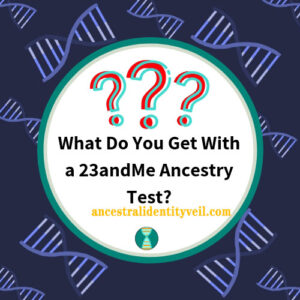Are You Curious About 23andMe Ancestry Test Results? Whether or not you know whether to get tested (or which test to get), or you’re waiting on results, this post can help you gain more insight into what information can be gleaned from 23andMe results.

Both my parents recently undertook the 23andMe Ancestry test, and I thought this would be an ideal chance for me to share what I have learned from their results with you. Since I’ve been researching my family tree using DNA for so many years now, my expectations were high regarding what might be revealed through their results.
Let me say this much, I am extremely satisfied with what I’ve learned thus far from 23andMe results. Here are a few of my favorites below.
Note: Please be aware that this post only discusses 23andMe’s Ancestry service; no details have been included regarding their health testing service.
Ancestry Composition Report on 23andMe is both interesting and enjoyable One of the most popular features of 23andMe DNA results is their Ancestry Composition report, also known as ethnicity estimate or ancestry estimate. This report will give an idea of where your family likely lived over several hundred years.
My theory about my dad’s side of the family tree involves his paternal grandmother being American while both her parents spoke German and reported as such on US Federal Census forms.
Political borders were constantly shifting throughout Europe in the latter half of the 19th and early 20th centuries, making it hard for us to pinpoint exactly where our ancestors originated from.
After discovering some evidence that my dad’s German ancestors may be ethnic Germans from Poland, I wondered whether this would show up on his 23andMe results. Below you can view his ethnicity estimate (ancestry composition), including an area highlighted in red: this could indicate where his ancestry lies.
My evidence led me in this direction, but it’s still very thrilling for me to discover Polish ancestry on my dad’s side of the family!
An impressive feature of the 23andMe Ancestry Composition Report is its “Ancestry Timeline”, which allows you to visualize where in your family tree ancestors from various regions contributed their DNA.
My dad agreed to me sharing his results (thanks, Dad!). Here are his results again.
With 23andMe you get DNA matches
While you may not realize it yet if this is your first post here on this site, DNA matches are my favorite part of DNA results. They allow me to explore and build family trees more effectively.
My parents’ DNA match lists did not disappoint at all! While my dad’s list appeared as anticipated, my mom found an incredible new close relative whom we were able to connect and determine our familial ties within just hours! Amazing!
This brings up an important point about 23andMe DNA results or any other type of DNA test which provides DNA matches: you might get some surprising matches! Keep this in mind before undertaking a DNA test.
DNA match lists are almost never incorrect and provide us with an excellent opportunity to explore our family tree. By learning about both our ancestors and living DNA relatives, our DNA matches give us more than we ever could imagine about how their genetic history developed over time.
Do You Want to Know How Much Neanderthal DNA You Have? My parents found their DNA results highly entertaining when they learned they could determine how much Neanderthal DNA each one had; there was much joking about which of them had more.
My mom insisted that my father was likely the most primitive one of us two. And she was correct!
23andMe provides testing of your DNA to look for over 2,000 variants that have origins in Neanderthal populations; most scientists agree that Neanderthals became extinct about 40,000 years ago.
I’ve always favored the theory that Neanderthals didn’t truly go extinct-if they did, why do most of us possess at least some Neanderthal genes in our genomes? And it appears I’m not alone – see also this article’s last line for confirmation).
Interbreeding between Neanderthals and modern humans has ensured the preservation of Neanderthal DNA until this day, with no sign of it going anywhere soon.